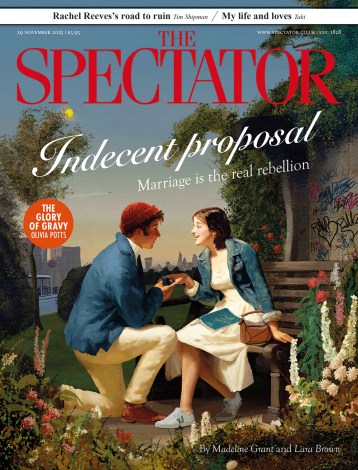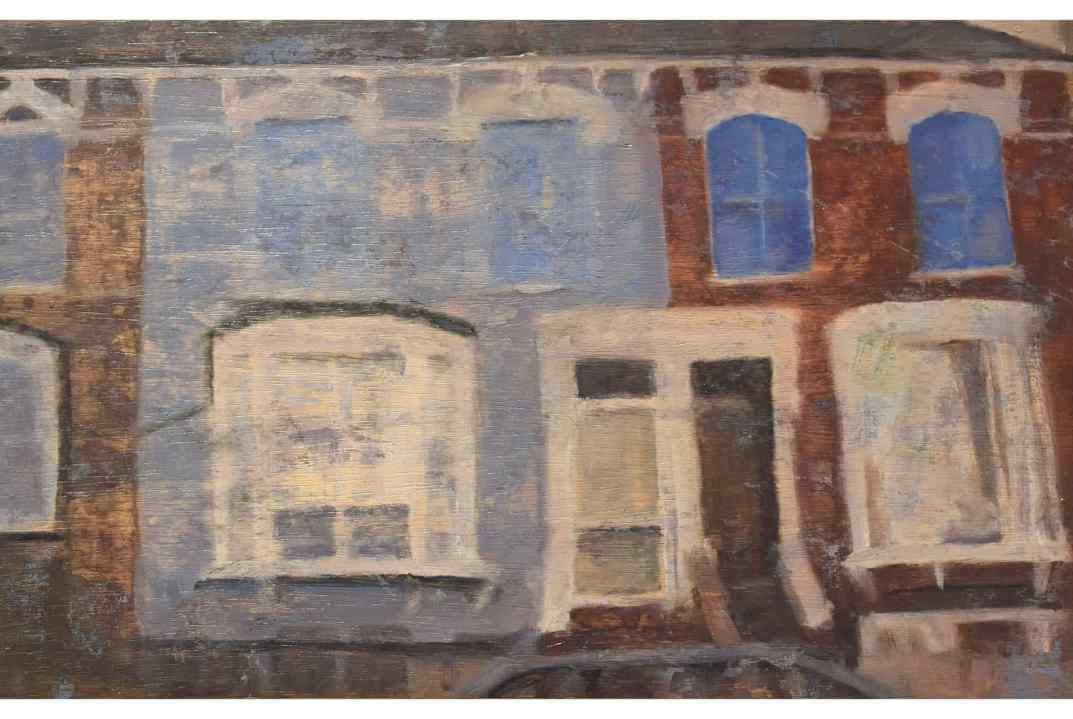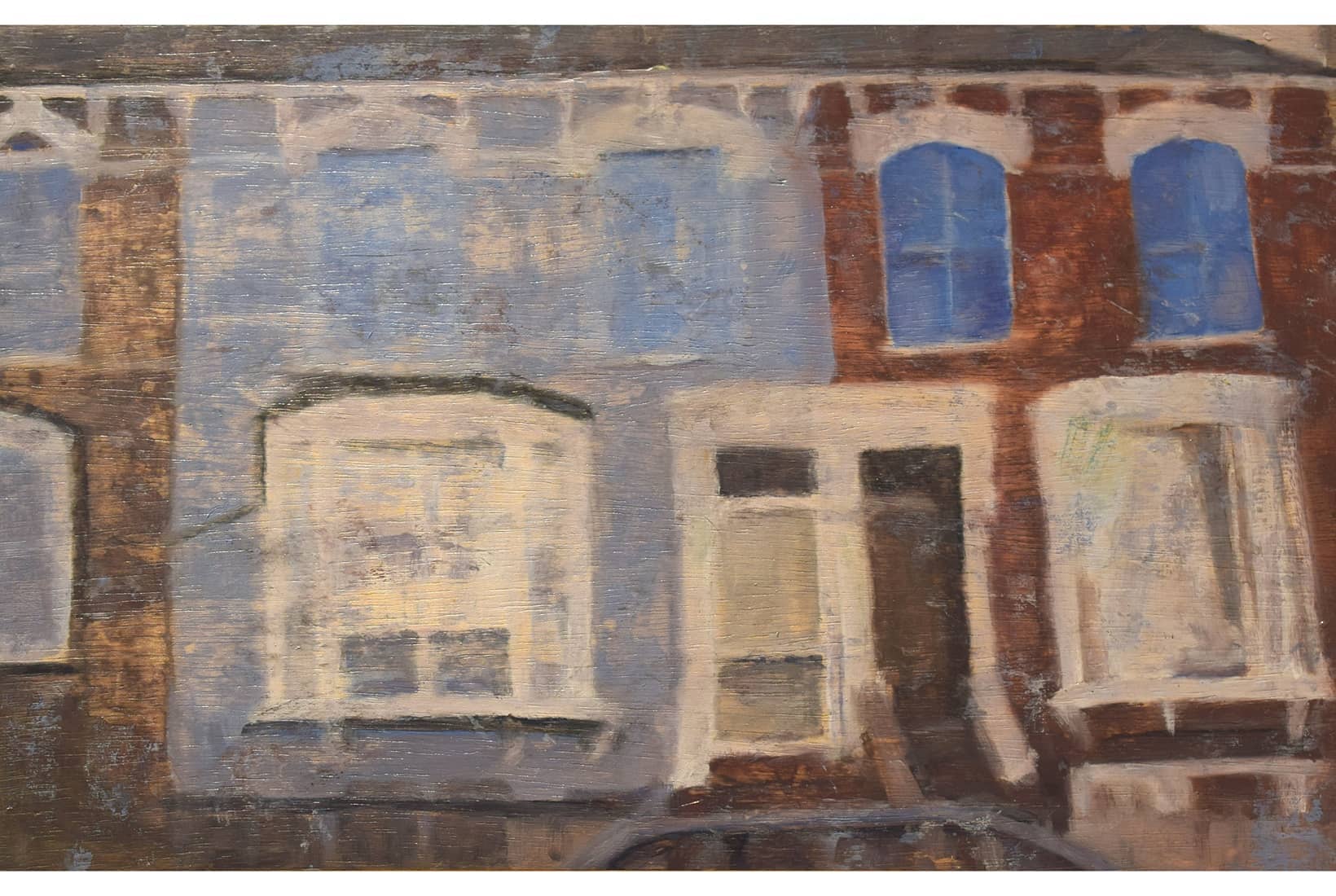Paintings of houses go back a long way in British art: the earliest landscape in Tate Britain is a late 17th-century view of an estate in Belsize Park by the inventor of the country-house portrait, Jan Siberechts. The genre quickly became déclassé. By the 18th century Thomas Gainsborough was painting peasant cottages; by the 20th, Algernon Newton had turned his attention to middle-class villas on London’s canals.
Not made for the owners of the houses they depicted, these paintings were destined to decorate the walls of strangers: the householders might not even know the pictures had been ‘taken’. A commissioned house portrait has legitimacy; a non-commissioned one feels like an invasion of privacy. A house portrait painted on spec invites speculation, encouraging nosiness about the occupants. Windows screened by reflections invite prying eyes, bringing out the net curtain-twitcher in us: a sotto in su perspective on bedroom windows could almost be classed as architectural upskirting.
A commissioned house portrait has legitimacy; a non-commissioned one feels like an invasion of privacy
A painting suggests so much more than a photograph. When an artist has taken the trouble to paint something, we imagine there must be a reason, and so an anonymous façade captured on canvas can easily acquire the frisson of a crime scene. Edward Hopper’s ‘House by a Railroad’ was perfectly innocent until Hitchcock rebuilt it on the set of Psycho.
This suspicion explains the slightly creepy air of Millennium Gallery’s exhibition Where We Live. The show was the brainchild of the artist Trevor Burgess, who 20 years ago developed a fascination with property ads in London papers and started pasting them into a sketchbook. He liked the muzzy newsprint and the way accidental elements — the shadow of a building opposite, the reflection of unseen trees in windows — subverted the commercial purpose of the ads; there was more to their banality, he felt, than met the eye. Friends couldn’t understand his fascination, but I can. Pictures of house fronts pique our human curiosity, raising the question immortalised by Loyd Grossman: ‘Who would live in a house like this?’
The series the ads inspired, ‘A Place to Live’, now runs to more than 60 images of London housing, from Victorian terraces to tower blocks, painted in thinned oil paint on unprimed plywood to replicate the graininess of newsprint. A selection hangs in the exhibition alongside works by four contemporary painters who share Burgess’s obsession with where we live. Each of them operates on a different turf. Jonathan Hooper has spent the past ten years painting the suburban semis surrounding him in Leeds, giving the nabis treatment to their mock-Tudor gables and Edwardian bay windows, dousing their neat façades in painterly colour. Narbi Price has been drawn to Ashington in Northumberland, former home of the Pitmen Painters, where since 2015 he has recorded in melancholy detail the decaying fabric — the obsolete phone box, the empty window — of what was once Britain’s biggest mining village.
Mandy Payne has focused on another community in transition: the Park Hill council estate in her native Sheffield. Condemned as a sink estate in the 1980s and 1990s, this brave new microcosm of modernism with its streets in the sky was only saved from demolition by its Grade II* listing and is now in the process of redevelopment. A lover of modernist architecture — ‘I find the brutalism beautiful’ — Payne paints her pristine images on concrete panels; the medium is the message. She began painting the estate as a student in 2012 when many of the flats were boarded up and the odd washing line or vase of flowers in a window were the only signs of life: her perspectives along shadowed walkways or down empty stairwells could be stills from a thriller. But it’s the traces of past lives that fascinate her, the patina of a fading utopia.
Judith Tucker’s ‘Night Fitties’ paintings celebrate the survival of a very different English housing initiative. The Humberston Fitties on the Humber Estuary — ‘fitties’ means saltmarsh — are among the last remaining plotlands in England, a relic of the interwar years when working-class people could buy plots and put up holiday chalets to their own design, free of planning regs. Nameplates preserve the freebooting spirit of the enterprise: Uncle John’s Cabin, Del Boy’s Den, Pottering Heights. Since discovering the place in 2011, Tucker has kept returning with her collaborator, the landscape poet Harriet Tarlo. Their ‘Night Fitties’ series pictures the chalets after dark, when residents are behind closed doors and dusky England flags and ‘keep off the grass verge’ signs are the only clues to their identities. Tucker is aware of the intrusion: ‘You’re peering in; everyone’s fenced off.’ Tarlo captures the tension in two words: ‘Welcome. Keep away.’
The façade a house turns on the street is just that, a façade: ‘Nothing is quite what it seems,’ says Tucker. There’s a sociopolitical dimension to this exhibition, but its paintings conceal the more poetic truth that every house that has ever been lived in is haunted.







Comments